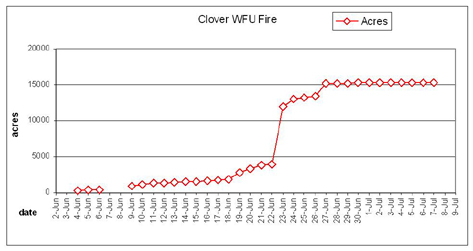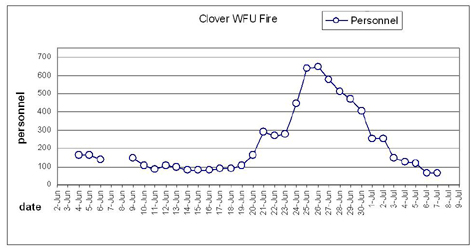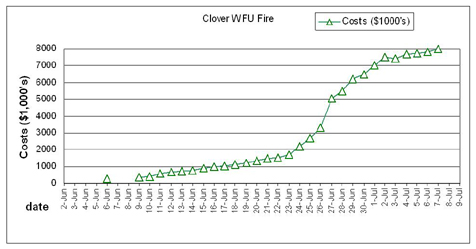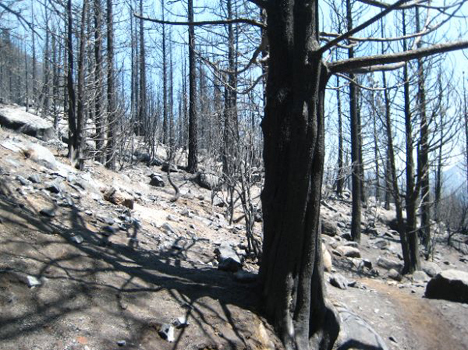The Clover WFU Fire
Yesterday and the day before, dry lightning raked California. Over 400 fires were ignited [here], from the Shasta-Trinity National Forest south through Mendocino County and all the way to the Sequoia NF at the southern end of the Sierra Nevada. State and federal fire crews are scrambling to do initial attack on fires that are still being detected as I write.
Two fires have been burning for weeks, though. The Indians Fire in the Los Padres NF (Monterey Co.) [here] was ignited by an untended campfire on June 8th. It is now over 50,000 acres and 55 percent contained. Over 2,500 personnel are fighting the Indians Fire; nine firefighters have been injured to date. Two residences and 13 outbuildings have been destroyed. The residents of upper Pine Canyon have been evacuated since June 18th. Nearly $30 million has been spent on fire suppression. Three new fires were ignited in the Los Padres by the dry lightning, and crews from the Indians Fire are engaging in initial attack on those right now.
The Clover WFU Fire [here] has been burning in the Sequoia NF since May 31st. WFU stands for Wildland Fire Use, and is a synonym for Let It Burn. The leadership of the Sequoia NF has been letting the Clover WFU burn for nearly a month. In the last week the fire has nearly tripled in size from 1,600 acres to over 4,000 acres.
Despite the WFU designation, nearly $2 million have been spent “monitoring” the Clover WFU Fire. The Pacific Crest Trail has been closed and hikers rerouted. Some suppression efforts have been implemented at the southern end of the fire north of Kennedy Meadows, but as of yesterday all that changed. The WFU designation is still in place but the monitoring crew has been “demobilized” and a Type 2 Incident Management Team ordered in. Personnel count on the fire has jumped from about 80 to nearly 300 firefighters and support teams.



The Clover WFU Fire is pulling resources away from critical need areas. This fire could have been suppressed in early June at less than 100 acres and less than $100,000. Instead $2 million have been spent, 4,000 acres have burned, and the rest of the state has been placed at reduced readiness for fires that are occurring elsewhere today.
The Sequoia National Forest alone has reported 25 fires from lightning storms of yesterday.
No NEPA process was instigated or even contemplated for the Clover WFU Fire, a federal management action on (federal) public property. No evaluation of impact to endangered species, water or air quality, no public hearings, no public input, and no legal review whatsoever were performed.
WFU fires are supposed to be lightning ignited, but it is not clear what started the Clover WFU Fire. From an InciWeb announcement of June 6th:
Upon initial investigation the probable cause of fire appeared to be human-caused. Further investigation has revealed the cause more likely to be lightning. … Initial investigation into the lightning detection/reporting program did not show recent strikes in the Clover Fire vicinity. The detection program is a computer program which may have not recorded all strikes due to a glitch in the system.
Based on that scant evidence, a WFU was declared. Fire managers spent three weeks preparing a Stage III WFIP (Wildland Fire Implementation Plan) that regulations say must be done within 48 hours. They presented that plan last Wednesday to the Sequoia NF leadership, and it was accepted, but now is moot as a Type 2 IMT has moved in to suppress.
The Sequoia NF Forest Supervisor is Tina Terrell:

WFU fires are supposed to provide “resource benefits,” but there have been no reports issued on what those might be. There has been no projected cost/benefit analysis, and no impact analyses on wildlife, watershed, airshed, recreation, anthropological sites, or other resource values.
More importantly, the Clover WFU Fire has placed the Sequoia NF in an unprepared position for the lightning ignitions they are experiencing today. The costs to resources and fire suppression efforts due to the dalliance with the Clover WFU Fire are difficult if not impossible to measure, but they are real.
It is also impossible to imagine that the Sequoia NF leadership thought that allowing a fire to burn from May until next Fall was in any way good forest management or stewardship, yet apparently that was the case.
The USFS is desperate to avoid NEPA and public involvement in their decision-making. They don’t want the public to interfere with their Let It Burn program. Yet public interference is desperately needed, because the USFS is making terrible decisions that lead to catastrophic costs and damages to public forests. The Clover WFU is a prime example of that, and sadly only one of dozens of such fires based on officious nonsense and disdain for public input.

From the Clover Burn, June 17, 2008. Photo courtesy Ron and Karen Burke’s 2008 Pacific Crest Trail Journal [here]. How is this beneficial to resources?
by Kennedy Meadows resident
by another Kennedy Mdws Resident
I was amazed by the justification that resulted in the ‘event’ changing from man-caused to ‘natural’. The FS stated that there had been thunder cells in the area days before but no evidence of lightening… so therefore it natural caused?
Sounded like reverse logic to me. If the FS wants to use this kind of logic in wilderness… O.K.by me… let it burn, baby. They will have to realize that eventually a fire will have to suppressed and that can be very expensive, e.g. the Manter fire!!
When the WFU was 40 acres, I was planning a trip to Monanche country and therefore I looked at the jet stream forecast and the NWS surface pressure gradients to check Monanche for forecast smoke. It was rather obvious that strong winds were predicted from the NW. Clear for Monanche but bad news for the Clover fire growth into new fuel to the east. I guess that in the case of a WFU the possibilities of the fire becoming catastrophic is anathema to the WFU philosophy!
Ah, the beauty of being an environmentalist! You can have your religion and justify your actions as being ‘Natural’!
by Max H.
The above article points out the ‘dis-involvement’ of the public in agency decision making. I don’t hear this often and it is encouraging that others experience out of control government. The problem of ’stake holders’ being disfranchised from decision making processes goes way further. It is systemic in our current government. For example, the CA Department of Fish and Game directors are political appointments that regularly reject the recommendations of the field biologists that our taxes support. Even though they likely have doctorates from universities our taxes support and are paid by us taxpayers. The BLM regularly closes roads at a whim with no local public input, bulldozes ancient buildings to return the ‘ecosystem’ to its ‘natural’ state, among other ‘improvements’. The forest circus is simply one of many government agencies run amuck.
The FS and the National Park Service have a long history of poorly planned and even lousier managed Let It Burn fires leaping out of control and doing $billions with a “b” in damages.
Cerro Grande (2000), Biscuit Fire (2002), B and B Fire (2003), Warm Fire (2006), the Payette and Boise Fires (2007), the Zaca Fire (2007) and on and on and on.
They have NO legal authority to do these things. Every other government action that impacts the environment needs to be reviewed under a variety of laws first: NEPA, ESA, NHPA, NFMA, CWA, CAA, etc. No such process for WFU’s. It’s criminal. Not to mention that they have lost 95% of their on-the-ground biological expertise with hiring strategies that ignore technical background and experience.
The USFS (United States Fire Service) lacks more than money. It lacks intelligence, common sense, and foresight. In fact, the amount of wilderness that has burned in the South Fork Kern River area in the last few years makes one wonder if the plan isn’t to burn up all the wilderness left in California to make it easier for developers to overtun the Wilderness Act and sell the land off.
First the Domeland is allowed to burn. Then the Golden Trout Wilderness. Now the South Sierra? They ought to be prosecuted for negligence!

Amazing stupidity seems to be a job requirement for these people. If you were in the area and saw how dry it was up there, it was obvious the Clover Fire was going to get out of control.